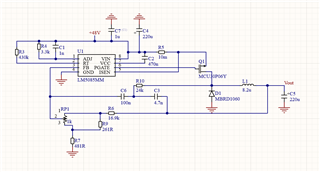I am using this chip in a design for a switching power converter. I'm not seeing any swtching at PGATE, it just remains high the whole time.
Vin = 48 V
Vout = 32 V to 45.7 V (there is a potentiometer on the feedback path to accomplish this)
Iout = 7.5 A, although I’m testing it at a nearly open load right now
Td = 102.6 ns (from my PFET’s datasheet)
Fsw = 500 kHz to 708 kHz (depending on Vout)
You can see the schematic for this design below.

I've checked all connections, I've tested this with an eload, everywhere from 10 kO to 100 O, and it's not switching at all. I tried replacing the IC, and I even tried replicating the design on page 17 of the datasheet, replacing R3 with a 100 kO resistor, R4 with a 2.2 kO resistor, R10 with a 68 kO resistor, and C3 with a 2.2 nF capacitor.
Nothing changes the output. I'm kind of at my wits end here and would appreciate any assistance. At this point, I don't care about current regulation or current limit, I just want to see some voltage regulation.

